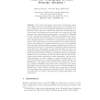659 search results - page 130 / 132 » Compiling and securing cryptographic protocols |
ESAS
2004
Springer
14 years 23 days ago
2004
Springer
The common perception of public key cryptography is that it is complex, slow and power hungry, and as such not at all suitable for use in ultra-low power environments like wireless...
SAC
2006
ACM
14 years 1 months ago
2006
ACM
In a recent work, we have shown that it is not possible to dependably build any type of distributed f fault or intrusiontolerant system under the asynchronous model. This result f...
GLVLSI
2009
IEEE
2009
IEEE
Physical unclonable function and true random number generator: a compact and scalable implementation
13 years 11 months ago
Physical Unclonable Functions (PUF) and True Random Number Generators (TRNG) are two very useful components in secure system design. PUFs can be used to extract chip-unique signat...
CSFW
2010
IEEE
13 years 10 months ago
2010
IEEE
We consider the problem of automating open bisimulation checking for the spi-calculus, an extension of the pi-calculus with cryptographic primitives. The notion of open bisimulatio...
CCS
2008
ACM
13 years 9 months ago
2008
ACM
We extend the Camenisch-Lysyanskaya anonymous credential system such that selective disclosure of attributes becomes highly efficient. The resulting system significantly improves ...

